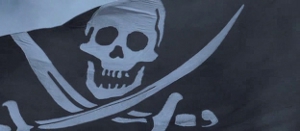
I’ve never been able to take pirates seriously. I blame Peter Pan. Neverland-centric adventures were the only context in which I encountered pirates during my land-locked childhood. Seeing them perpetually made fools of by a pack of flying children (who may or may not have been vampires, led by one of the darkest Dark Princes since Dracula…and his house-fairy) did not endear pirates to me, and tales of so-called “adventure” on the Early Modern Era’s high seas always struck me as horror stories by another name.
If you’ve read them, you know what I’m talking about: there are parts of Moby Dick fit to make even the hardest hardcore Saw fan curl up into a ball of tears and barf (which is why Moby Dick‘s screen adaptions usually omit those parts). Really-real life accounts of long sea voyages during that First Great Age of Colonialism are all about misery, deprivation and discomfort. I swear, before the invention of mass media, people could not shut the fuck up about their toothaches. Or “the scurvy.” And if it wasn’t “the scurvy” it was “the pox.” If it wasn’t “the pox” it was “consumption.” And if it wasn’t “consumption…”
You get the idea. Hopefully, by now, you’ll also have some idea as to why most Pirate Movies are fanciful romps, set in highly-romanticized alternate universes where grown ass men can spend their whole lives at sea but still come ashore with perfect teeth. Men like Douglas Fairbanks, or Erol Flynn. Or Douglas Fairbanks, Jr. Or Burt Lancaster. By the time my mother was in grade school, pirate movies had at least grown the balls to cast unattractive dudes as sea dogs – like Robert Newton. Or Yul Brenner. But that didn’t last. The year I was born was also the year Pirates of Penzance came out, thrilling absolutely no one and proving not a goddamn thing had changed since the Silent Era. Continue reading Pirates of the Caribbean: Curse of the Black Pearl (2003)
